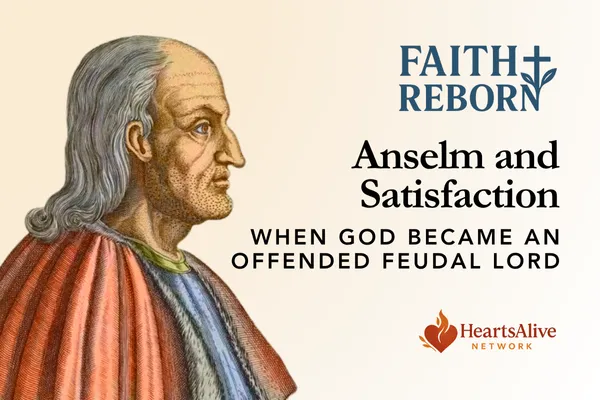
Anselm and Satisfaction: When God Became an Offended Feudal Lord
Unless you owned a castle, the early Middle Ages were a tough time to be alive. The feudal system of lords and servants didn’t just shape society—it reshaped Christian belief.
After the fall of the Roman Empire, the Western world became increasingly unstable. Without the unifying force of Rome, raiders and warlords plundered towns and villages. In response, people gathered under the protection of wealthy landowners. In exchange for loyalty and labor, the lord offered safety within his kingdom.
In this system, loyalty and honor were everything. To dishonor a feudal lord—the very person who protected you and your family—was considered a crime worthy of severe punishment. Only a brutal penalty could satisfy the wrath of the dishonored lord.
Enter Anselm of Canterbury
Born into this world in 1033, Anselm of Canterbury absorbed the logic of feudal society. And the world around him was changing fast:
1054 – The Great Schism split the Church into Eastern Orthodox and Roman Catholic.
1066 – The Normans conquered England, transforming its political and religious structures.
1084 – A major reform movement erupted within the Catholic Church to address deep corruption.
1095 – The First Crusade launched, beginning centuries of holy war in the name of Christ.
Anselm was a priest, philosopher, and theologian. In 1093, just before his 60th birthday, he became Archbishop of Canterbury. But he quickly clashed with King William II and was exiled to Rome just four years later.
During this exile, Anselm wrote what would become one of the most pivotal works in Western theology: Cur Deus Homo(Why God Became Man), an exploration of the atonement—why Jesus had to die.
The Logic of Satisfaction
Having grown up in the feudal world, Anselm saw humanity’s relationship to God through the same lens that governed life under a feudal lord. Sin, to Anselm, was a dishonoring of God’s glory—a cosmic offense against the King of kings.
Here’s how the logic goes:
Sin is disobedience and failure to give God the honor He is due.
God’s justice demands that this honor be repaid or satisfied.
No human can repay the magnitude of this dishonor.
Therefore, God Himself must become man to satisfy His own justice.
This became known as the Satisfaction Theory of Atonement. Jesus had to die to satisfy the Father’s wrath while upholding His mercy.
Logically, this system works: God’s justice is upheld through satisfaction. His mercy is demonstrated by sending His own Son. But something about this picture feels off. It fits with the logic of medieval feudalism, but not with the Father revealed in Jesus.
What’s the Problem with Satisfaction Theory?
1. God Is a Loving Father, Not a Feudal Lord
Certainly, the Father does not want His children to sin—but not because it offends His ego or challenges His honor. As any good father knows, sin brings consequences that hurt the child.
If sin is looking for life outside the goodness of the Father, then it includes idolatry, which places people in bondage to dark powers. The biblical story is of a faithful Father who redeems His children when they are enslaved.
Jesus didn’t die to appease a dishonored Father. He gave His life to rescue humanity from bondage. The New Testament repeatedly speaks of Jesus’ death as a ransom—not to the Father, but to liberate from the forces of darkness. It wasn’t a lavish display of divine vengeance, but an act of profound rescue.
2. Justice Gets Disconnected from Relationship
Anselm’s framework is built on abstract justice, not relational love. This was shaped by the world he inherited:
Jerome’s Latin translation of metanoia ("change of heart") as paenitentia ("penance") shifted repentance from transformation to legal ritual.
Augustine’s view of original guilt meant all humans were born already condemned.
By the time Anselm wrote, Christianity had absorbed a deeply legalistic view of salvation. The cross became a courtroom drama, not a family rescue story. We offended God's infinite honor. We owed a debt we couldn’t pay. So God paid Himself, to satisfy Himself.
But the New Testament tells a different story—one of reconciliation, not just reparation.
3. Sin Becomes a Debt, Not a Wound
From Augustine to Anselm, sin morphed into a legal debt. Anselm’s version made the debt so massive, so offensive, that only God could pay it.
But what if sin isn’t just a debt to be paid? What if it’s a wound to be healed, a captivity to be broken?
When Jesus begins His ministry, He doesn’t speak of wrath or debt. He reads from Isaiah in the synagogue, as recorded in Luke 4:18–19:
“The Spirit of the Sovereign Lord is upon me, because He has anointed me to bind up the brokenhearted and to proclaim liberty to the captives.”
He doesn’t say, “You sinful people racked up a debt so big I had to come pay it off.” He speaks of healing the shattered heart (leb shabar in Hebrew) and freeing the captives. He finishes the passage by proclaiming "the year of the Lord’s favor"—and skips the next line, which mentions "the day of vengeance of our God."
That omission is intentional. Jesus didn’t come to satisfy the wrath of a vengeful Father. He came to reveal the love of a healing Father.
The Father We Meet in Jesus
Anselm’s Satisfaction Theory made sense in the violent, honor-bound world of the Middle Ages. But we must ask: Does it reflect the God revealed in Jesus?
Jesus shows us a Father who runs to the prodigal, not one who waits to be appeased. He shows us a God who heals the broken, not a feudal lord who demands repayment.
The cross is not a payment extracted by divine wrath. It is the climactic act of divine love—a Father in Christ, reconciling the world to Himself.
God was in Christ, reconciling the world to Himself—not counting their sins against them. (2 Cor. 5:19)
That’s not satisfaction. That’s grace.
The Enduring Impact of Satisfaction Theory
The logic of satisfaction didn’t stop in the Middle Ages—it took deep root in the Western Christian imagination. From Anselm’s formulation came even more juridical views of salvation, culminating in penal substitution during the Protestant Reformation. In this version, Jesus not only satisfies God’s honor but absorbs God’s wrath as a substitute for sinful humanity.
This shift has deeply shaped modern Christianity:
God is often portrayed as distant, angry, and needing appeasement.
The cross becomes more about punishment than healing or victory.
Salvation is reduced to a legal transaction rather than restored relationship.
Many Christians live with chronic guilt, shame, and anxiety about God’s judgment.
While the logic of satisfaction may have fit the cultural and political context of medieval Europe, it has obscured the biblical picture of a God who is, at heart, a loving Father committed to healing, restoring, and reconciling His children.
Recovering the story of Jesus as liberator, healer, and reconciling Son helps us rediscover what was always true: God’s justice is not retribution—it’s restoration.
We see how deeply satisfaction theology has embedded itself in the Christian imagination even through worship. One of the most popular modern hymns, In Christ Alone, includes the line:
"Till on that cross as Jesus died,
The wrath of God was satisfied;
For every sin on Him was laid—
Here in the death of Christ I live."
This lyric reflects the enduring influence of Anselm’s logic: God’s wrath needed to be satisfied, and the cross was the payment.
As we get closer to our own theological time and language, it becomes more emotionally and spiritually challenging to examine these inherited beliefs. Many of us have sung these songs with sincerity and deep gratitude. This isn’t about rejecting the heart behind such worship—it’s about being open to how theology has been shaped by history, culture, and human systems.
With humility, we can begin to ask: Is this the picture of the Father we see in Jesus? And are there other voices in Scripture—perhaps older and more relational ones—that need to be recovered for a fuller view of the cross?
Reexamining satisfaction theory isn't about deconstructing faith—it’s about refining our understanding of who God is, so we can love and worship Him more fully, in spirit and in truth.


